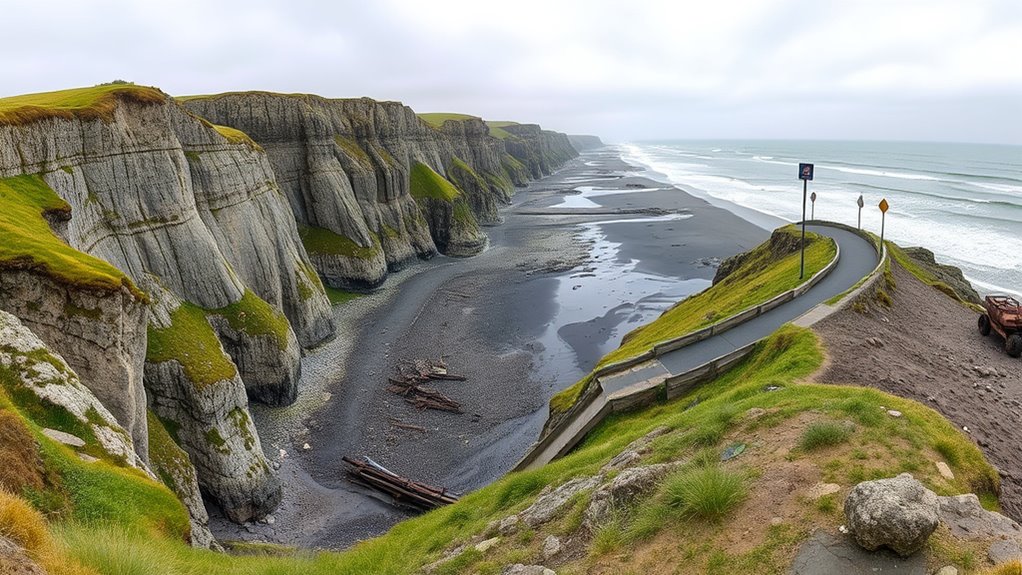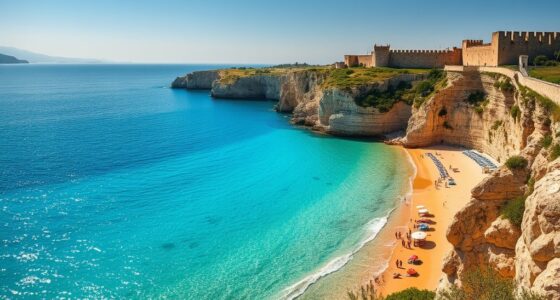The Normandy D‑Day Beaches Historical Route guides you through the critical invasion that turned the tide of WWII. You’ll explore key beaches like Utah, Omaha, Gold, Juno, and Sword, discovering how strategic planning and fierce battles shaped history. Along the way, you’ll visit memorials, museums, and landmarks honoring the bravery of those involved. Continuing your journey reveals powerful stories and important sites that connect you to this pivotal moment in history.
Key Takeaways
- Explore the five main beaches: Utah, Omaha, Gold, Juno, and Sword, where pivotal landings occurred during D-Day.
- Learn about the strategic planning, including terrain analysis, resource coordination, and naval support that enabled the invasion.
- Visit memorials, museums, and landmarks that commemorate soldiers’ sacrifices and provide historical insights.
- Understand the initial landing operations and key battles that shaped the success of the Normandy invasion.
- Discover the importance of allied cooperation, logistical planning, and terrain study in executing the historic landings.
The Strategic Significance of Normandy in WWII

Normandy held immense strategic importance during World War II because its beaches provided the most viable entry point for the Allied invasion of Western Europe. Controlling this region allowed the Allies to establish a foothold on the continent and weaken German defenses. Aircraft carriers played a crucial role in the naval battles surrounding Normandy, providing air cover and launching strikes against German positions. These naval battles helped secure the sea lanes, ensuring the invasion force could land safely and sustain its momentum. The ability to project naval power through aircraft carriers and dominate the Atlantic was essential for the success of the operation. Additionally, the presence of naval support was vital in ensuring the success of the amphibious assault and subsequent operations. The integration of naval and air power was a key factor in overcoming German defenses and achieving strategic victory. Recognizing the importance of naval dominance underscores how control of sea routes was essential for logistical support and overall success during the campaign. Maintaining sea control also allowed the Allies to supply and reinforce their troops effectively throughout the campaign. Moreover, naval supremacy enabled the Allies to disrupt German supply lines and hinder their ability to mount counterattacks, further solidifying their strategic position.
Planning and Preparing for the D-Day Invasion
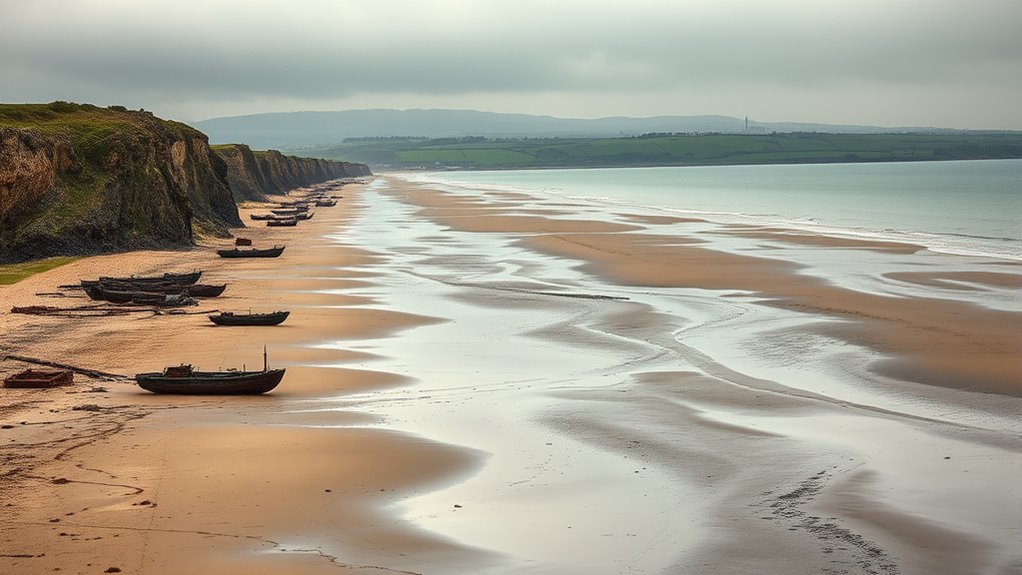
To prepare for the D-Day invasion, you need to focus on gathering essential supplies and ensuring everything is ready for the massive operation. Coordinating with your allies is vital to synchronize efforts and share resources effectively. Studying the terrain and maps helps you choose landing sites and develop strategies to overcome defenses. Additionally, familiarizing yourself with survival gear can be crucial for handling unexpected challenges during the operation. Incorporating data-driven strategies can help you assess risks and optimize your planning process for better outcomes. Utilizing portable camping gear can enhance mobility and readiness in various environments, ensuring you are well-equipped for the diverse conditions of the battlefield. Regular maintenance of your equipment, such as heat pump systems, can ensure optimal performance when needed most. Understanding strategic planning plays a key role in the success of complex operations like the D-Day invasion.
Gathering Essential Supplies
Before launching an invasion, meticulous planning and preparation of essential supplies are crucial to guarantee success. You need to focus on supplies logistics and resource management to ensure everything arrives on time and in good condition. Properly gathering supplies involves selecting key items that support the troops and sustain operations. Additionally, maintaining proper comfort and support solutions can help improve the well-being of personnel during extended operations. Here are three critical supplies to prioritize:
- Food and water supplies to keep soldiers energized and hydrated.
- Medical kits for emergencies and injuries.
- Ammunition and weapons to maintain combat readiness. Effective resource management minimizes waste and prevents shortages during the invasion, especially as self-serve options become more prevalent in large-scale operations. Incorporating long-term survival foods can also improve resilience and reduce logistical burdens over extended campaigns. Recognizing the importance of emotional resilience among troops is vital for maintaining morale and mental well-being during prolonged engagements. Additionally, supply chain coordination is essential to synchronize delivery schedules and avoid delays. By carefully coordinating these supplies, you ensure your forces are well-equipped, bolstering their confidence and increasing the chances of success on D-Day.
Coordinating With Allies
Coordinating with allies is crucial to guarantee all forces work seamlessly during the D-Day invasion. You’ll see how essential allied coordination was in planning joint operations across multiple nations. Leaders from Britain, Canada, the United States, and other allies collaborated closely to synchronize their attacking strategies, timing, and logistics. Communication channels were established to ensure real-time updates and adjustments, reducing confusion during the chaos of invasion day. This cooperation allowed for effective allocation of resources, overlapping artillery support, and coordinated landings on various beaches. By working together, the Allies created a unified front that maximized their strengths and minimized weaknesses. Your understanding of these joint operations highlights the importance of meticulous planning and international cooperation in achieving a successful D-Day invasion. effective coordination played a vital role in the success of the operation. Additionally, detailed logistical planning was essential in managing supplies, troop movements, and timing across different units to ensure operational success. Moreover, establishing clear communication protocols and shared command structures strengthened allied cooperation, ensuring synchronized efforts across diverse forces.
Studying Terrain and Maps
Studying the terrain and maps was a critical step in planning the D-Day invasion, allowing Allied commanders to identify key geographic features and potential obstacles. Through terrain analysis and map interpretation, they gained insights into beaches, cliffs, and inland defenses. This process helped determine the best landing sites and tactical approaches. Here are three key aspects: 1. Analyzing elevation and natural cover to assess vulnerability and strategic advantages. 2. Interpreting maps to locate obstacles like mines, barbed wire, and fortified positions. 3. Understanding tidal patterns and beach profiles to plan landing timings and routes. Additionally, examining unique and wicked planters provided inspiration for innovative approaches to terrain utilization and camouflage strategies used during the operation. Recognizing the importance of terrain analysis contributed to the success of the invasion by enabling more precise planning and surprise tactics.
Utah Beach: The Americans’ First Footprints
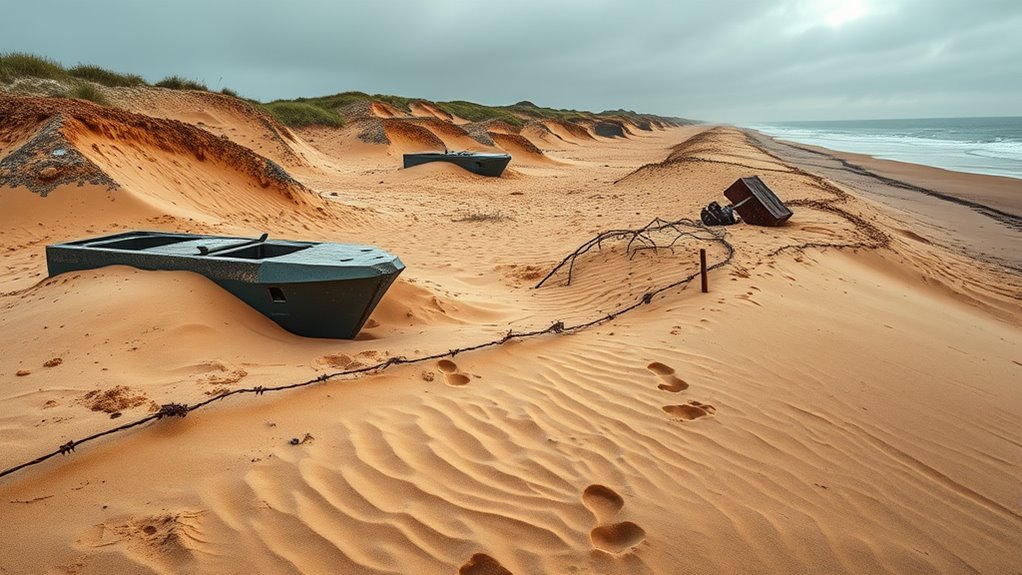
As you explore Utah Beach, you’ll see where the Americans made their first footprints on D-Day. These initial landing operations played a vital role in gaining a foothold in Normandy. Their strategic significance helped shape the success of the overall invasion. Visiting the site also offers insight into the historical importance of the event and the enduring legacy of those who fought there. Additionally, understanding the AI security measures that protect historical data can enhance the preservation and accurate interpretation of such pivotal moments. Recognizing the personality traits of the soldiers involved can deepen your appreciation of their resilience and camaraderie. The stories of individual bravery and family dynamics also shed light on the personal sacrifices made during this crucial chapter in history.
Initial Landing Operations
The initial landing at Utah Beach marked the first American footprints on Normandy’s sands, setting the stage for the broader invasion. You’ll notice how paratrooper tactics played a vital role, with airborne troops securing inland routes before the beach assault. Naval bombardments targeted German defenses, softening enemy positions and clearing obstacles. As you explore, keep in mind these key moments:
- Troops advanced quickly, overcoming minimal resistance thanks to prior aerial and naval support.
- Paratroopers captured key inland positions, disrupting German counterattacks.
- Naval bombardments suppressed heavy defenses, allowing landing forces to establish a foothold.
This coordinated effort was essential, demonstrating how combined arms tactics paved the way for the successful American push further inland.
Strategic Significance
Securing Utah Beach was a crucial step that set the tone for the entire Normandy invasion. Its strategic location allowed Allied forces to establish a foothold in France, enabling further advances inland. Aircraft tactics played a vital role, providing close air support and disrupting German defenses before and during the landings. Naval strategies ensured the transport and landing of troops while maintaining control of the coastline. The success here minimized German counterattacks and paved the way for subsequent beaches. By establishing a secure beachhead, you enable logistical operations and reinforce the Allied momentum. The combined efforts of aircraft tactics and naval strategies made Utah Beach a pivotal point in the overall success of D-Day, demonstrating the importance of coordinated military planning in achieving victory.
Omaha Beach: The Battle for Survival

Omaha Beach became one of the most intense and harrowing battlegrounds of D-Day, with soldiers facing brutal German defenses under heavy fire. As you stand on the shore, you see landing crafts approaching amid chaos, their roar drowned by gunfire. Soldiers had to navigate treacherous terrain, exposed to enemy fire, while under the cover of code names like “Dog” and “Easy Red.” The landing was a desperate struggle for survival, with many soldiers wounded or lost before reaching the sand. The fierce resistance delayed the Allied advance, but perseverance and bravery turned the tide. Here’s what you’ll learn:
Omaha Beach’s brutal defenses challenged Allied soldiers amid chaos and heavy fire.
- The challenges of landing crafts under fire
- The significance of German defenses
- The impact of code-named operations on strategy
Gold and Juno Beaches: Key Allied Landings

As Allied forces landed on Gold and Juno Beaches, they faced a mix of well-prepared defenses and challenging terrain that tested their resolve. The beaches were lined with formidable beach defenses, including bunkers, barbed wire, and obstacles designed to slow the assault. Landing craft approached through heavy fire, forcing troops to navigate rough seas and limited visibility. On Gold Beach, British forces faced strong defenses but quickly made progress inland, aided by effective artillery support. Juno Beach saw Canadian troops encountering fierce resistance from fortified positions, yet they pushed forward steadily. The combination of strategic planning, bravery, and the resilience of the troops helped overcome the tough beach defenses. These landings marked a essential step in establishing a foothold in occupied France.
Sword Beach and the Final Push
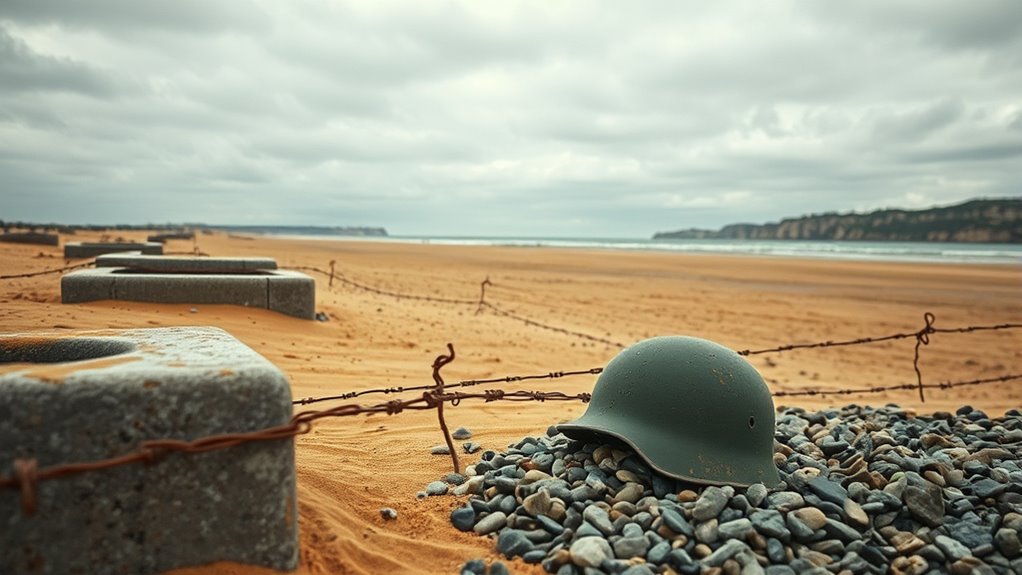
Despite facing formidable defenses, Allied forces landing on Sword Beach pressed forward with determination, marking the beginning of the final push into occupied France. The success relied heavily on effective artillery tactics that silenced German defenses and created breaches for the infantry. Meanwhile, codebreakers’ efforts played a vital role, intercepting German communications and guiding Allied strategies. As the beachhead expanded, your focus shifted to overcoming stubborn pockets of resistance. Key moments included:
- Coordinated artillery strikes that neutralized enemy strongpoints.
- The use of intelligence from codebreakers to anticipate German movements.
- Relentless infantry advances pushing inland, breaking through defenses.
This combination of tactics and intelligence kept the momentum strong, enabling the Allies to push deeper into France and set the stage for the final chapters of liberation.
Sites of Commemoration and Memorials

Memorials and commemorative sites along the Normandy beaches serve as powerful reminders of the sacrifices made during D-Day. You’ll find veteran memorials honoring those who fought and lost their lives, offering a space for reflection and gratitude. Artillery placements, preserved or marked, highlight the strategic importance of the battlefield and the intense combat that occurred. These sites often feature plaques and sculptures that tell stories of heroism and resilience. As you visit, you gain a deeper understanding of the scale of the operation and the bravery involved. These memorials connect you to the history, ensuring that the courage of the soldiers is never forgotten. They serve as poignant symbols of sacrifice, inspiring future generations to remember and honor the past.
Exploring Museums and Historical Landmarks
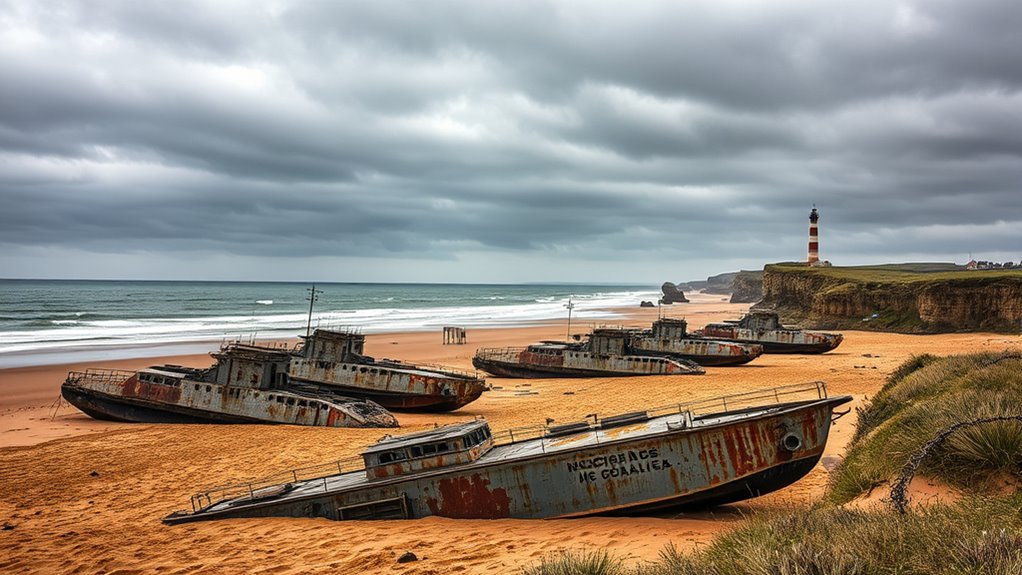
Visiting museums and historical landmarks along the Normandy beaches offers a tangible connection to the events of D-Day. These sites showcase essential aspects like naval battles and wartime logistics that shaped the invasion’s success. You can explore exhibits detailing the naval battles that secured sea routes and provided vital support for landings. Additionally, landmarks such as the Utah Beach Museum reveal how wartime logistics coordinated supplies and troop movements under intense pressure.
Here are three must-see sites:
- The Caen Memorial Museum, highlighting military history and strategic planning.
- The Utah Beach Museum, focusing on amphibious landings and logistics.
- The Arromanches 360 Circular Cinema, illustrating the artificial Mulberry harbors used during the invasion.
Frequently Asked Questions
Are Guided Tours Available Along the Normandy D-Day Beaches?
You’ll find plenty of guided tour options along the Normandy D-Day beaches, catering to different interests and schedules. Many operators offer guided tours, including private tour availability for a more personalized experience. These tours typically cover key sites and provide insightful commentary, making your visit more meaningful. Whether you prefer group excursions or private arrangements, you’ll have no trouble finding a guided tour that suits your needs and enhances your understanding of this historic area.
What Are the Best Times of Year to Visit the Beaches?
Imagine visiting the beaches in late spring, when the weather is mild and the landscape blooms—it’s ideal for exploring without huge crowds. The best times to visit are late spring and early fall, when seasonal weather is pleasant, and visitor crowds are smaller. Summers can be busy, especially in July and August, so plan accordingly if you prefer a quieter experience, and enjoy the history without the hustle.
Can Visitors Access Underground Bunkers and Tunnels?
You can access underground tunnels and bunkers during your visit, as many sites offer guided bunker tours. These tours let you explore underground tunnels, learn their history, and see preserved bunkers firsthand. Be sure to check ahead, as access varies by location and season. Participating in bunker tours enhances your understanding of the strategic importance of these underground structures during D-Day, offering a compelling, immersive experience.
How Long Does It Typically Take to Explore All Major Sites?
Did you know most visitors spend about 4 to 6 hours exploring the major sites? Your sightseeing duration depends on how many places you want to see and how in-depth you explore each one. For a thorough experience, plan for a full day, including breaks. If you’re short on time, a half-day visit can cover the highlights. A good time estimation helps you make the most of your trip without feeling rushed.
Are There Any Annual Commemorative Events on the Beaches?
You’ll find that annual memorials and veteran reunions on the beaches are powerful events that honor those who served. These commemorations typically happen around June 6th, marking D-Day anniversary, and bring together veterans, families, and visitors. Participating in or witnessing these events gives you a heartfelt connection to history. Be sure to check local schedules, as some ceremonies may include parades, memorial services, and educational programs.
Conclusion
As you walk these historic beaches, as you visit the memorials, as you reflect on the sacrifices made, you connect with the courage of those who fought, the importance of strategy, and the power of unity. You honor the past, embrace the present, and inspire the future. You see history in every footprint, hear stories in every monument, and feel the enduring legacy of D-Day. You carry this memory forward, forever grateful, forever inspired.
